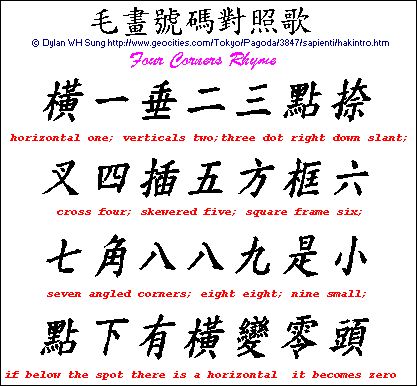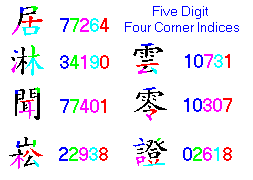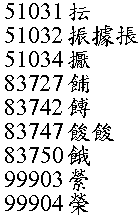


The example shows the character for "complexion" (M. yan, C. ngan, H. ngan2). To apply the four corner method, we have to identify the elements of the four corners of the character in question. We start at the top left hand corner first, then the top right, next the bottom left hand corner and finally the bottom right hand corner. With the four numerals we can identify any character to a small group for easy comparison.

| 0 | represents a dot and a horizontal line |
| 1 | the chinese character for one is a horzontal line. Its variants are the bottom horizontal of the 'earth' radical; the three stroke water variant's lowest stroke and the right handed horizontal hook feature. | |
| 2 | representing the straight vertical and its slightly left down-slanting line variant and also any vertical hook types | |
| 3 | This is represented by the dot, and also the right down-slanting line variant of the dot | |
| 4 | all types of cross types except where seen in | |
| 5 | this is a line which has skewered more than two lines | |
| 6 | All box or square shaped portions of the character | |
| 7 | These are mainly consist of angled corners | |
| 8 | the chinese number eight is formed by a forward and a back slash /\, variants may have open tops or closed tops as in the word person M='ren', C.='yan', H.=''ngin' | |
| 9 | the word for small, and parts of any character that has this potential appearance M='xiao', C.='siu' H.='siau' |
In the copy of the four corner dictionary that I have, SiJiao HaoMa Xin CiDian (  ) published by ShangWuYin ShuGuan (
) published by ShangWuYin ShuGuan (  ), it gives three possible characters for the index 0128.
), it gives three possible characters for the index 0128.

Sometimes, an extra number is added as a refinement of the above method. The area near the last digit of the four corner index is looked at, and it should not be covered by any stroke which has been already used in the first four digits. In our three characters above, the box element indicates that they all have the refinement 6. Hence the numberal is 01286 or 01286.
Below is a sample from a list of 4 corner numbers, containing five numerals for even more accuracy.

|

|
The last numeral is derived from the region of the middle of the character or immediately before where the fourth element was identified. The number system can theoretically be extended so that each and every character has a unique number assigned to it.
An good introduction to the method is found in H.R. Williamson's "Teach Yourself Chinese" (1968). The following is a quote from it.
IV. Characters whose four corners are exactly the same may be subdivided by a supplementary corner, which shall be a stroke just above the lower right corner and whose ends shall not be covered by any other stroke. A zero shall take the place of this stroke, if it has already been taken for another corner.
Characters whose five corners are exactly the same may be again subdivided by counting the number of strokes that belong to Class 1 and adding that figure as a decimal after the fifth figure. For example characters Shi (market as in Shi4 Chang3) and Di4 (ruler as in huangdi) are represented by the same number, 00227,

but Shi contains two strokes of Class 1 and Di contains three; so the former is represented by 00227.2 and the latter by 00227.3. The principle can be carried down further with the counting of strokes of Class 2, until every character has its exact position."